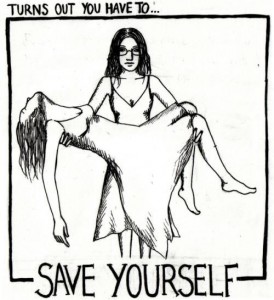Social little creatures that we happen to be, people are found to frequently, and often unpleasantly, involve themselves in the affairs of others. The unpleasantness seems to result from the fact that people’s involvement in these affairs is hardly ever selfless or unattached. After all, we wouldn’t tend to get involved in regulating the behaviors of others if there was no benefit to doing so. Sometimes people’s motives can be fairly transparent: for instance, that single guy who’s sexually interested in a girl will probably give her somewhat-different relationship advice than that girl’s female friends with no such interest. Now that example happens to be one where a consciously-held proximate motive happens to line up fairly-well with the ultimate reason for that motive’s existence (i.e. the man is sexually interested in the girl, and the advice he gives might have functioned to secure additional mating opportunities for himself). Other cases are less transparent, owing to people not having much conscious insight into the reasons they have certain thoughts or feelings: as another for instance, people might be interested in legislating the sexual behavior of others in order to improve the viability of their sexual strategy. However, on a conscious level all they might experience is a feeling of “that’s gross”, or “that’s not right”.
“I hate mustard. You shouldn’t be allowed to eat it”
These less-transparent cases pose us with some rather interesting mysteries to solve, mostly because explaining why I might not wish to do something is a much different task than explaining why I might want to stop other people from doing that thing. One such mystery has recently landed at my feet, and I wanted to explore it today in order to try and figure out my own thoughts on the matter (despite the Onion recently telling me such a feat is folly). I came across this example owing to my new-found love for an online card game called Hearthstone. The game operates similar to other existing card games: you have a pool of cards from which you can select a certain number to build your deck. Every player starts out with a beginning pool of cards for free which they can then expand and improve by opening online packs or unlocking certain class-specific cards through playing that class enough. If you’re really into showing off, there are also golden versions of the cards, which function precisely as the normal ones do, but are much rarer and harder to get. They’re basically the spinning rims of the game.
Now having access to all of the cards in the game provides an additional degree of flexibility in terms of what decks you can make. Accordingly, many people would prefer to get full collections. Owing to the free-to-play setup of the game, this either takes a lot of time (spent earning in game packs through play) or a lot of money (you can also buy packs). For the most part, I have taken the former route, and during my time not spent playing, when I should be doing other things, I sometimes like to watch YouTube videos of other people playing to learn and improve (and put off meaningful work). If you’re really looking to kill some time without deluding yourself into thinking you’re spending it productively, though, there are also videos of people just opening online packs. It just so happens that one of those videos happens to be what drew my attention. In the video (which can be viewed here if you have over 2 hours to waste), a man has bought 600 of these online packs for his three-year-old son’s account which he records opening. In real money, that works out to roughly $750.
What drew my interest was not the video itself; that part is actually quite dull. Instead, I found my reaction to it rather noteworthy: when I saw the video, the first thought to cross my mind was, in essence, “This guy is an asshole for spending so much money on those packs”. This sentiment was apparently not unique to me, judging by some comments. Choice selections of them include: he’s an idiot (“Blizzard won the battle. Got this idiot to spend more than $750 for his son…“), he’s neglectful of his children (“This isn’t a good dad in any way…I’d take love and care above 600 hearthstone packs anyday“), or just an all-around bad person (“Who is this twat?”). I find my initial reaction, as well as the ones in the comments section, rather puzzling. Specifically, why do such harsh, negative reactions arise to someone spending his money on, at worst, something he likes, and, at best, a gift for his child? At first glance, it certainly doesn’t seem like this purchase is doing any harm to the world.
“Who does that bitch think she is, buying gifts for her child?!”
There are a number of candidate explanations for this apparent moral outrage we might explore. One of these explanations is that perhaps people were outraged because they thought this man was buying a competitive advantage for himself or his child. This is a common complaint leveled by gamers against ostensibly “free-to-play” games: while the game might be “free” to play, one might need to “pay-to-win”, barring an incredible investment of time and energy which very few people with real responsibilities can make. In one respect, then, buying all those packs might have been condemned for the same reason that people condemned wealthy individuals for “renting” disabled tour guides to skip the lines at busy theme parks. If the father is paying to make his child better off relative to other people, then those other people might understandably get a bit salty about their newly-found competitive disadvantage. Without going too in-depth into the mechanics of the game, however, this explanation seems to hinge on the idea that having access to all those cards provides a competitive edge one could not get without them, and there’s a good deal of evidence to suggest that the advantage of the additional cards, if it exists, might be relatively minimal in some cases. In any case, I wouldn’t rule that explanation out as part of the overall picture.
Nevertheless, I don’t think this could possibly be the whole story. I say that for a number of reasons. First, there was a story that I discussed semi-recently: the reactions another comments section had to Kim Kardashian donating 10% of her eBay auction proceeds to charity. In this case, she was not disadvantaging anyone – quite the opposite – but was still branded as a horrible person by many commenters. Second, I try to imagine whether or not people would have the same reaction to the initial father in question buying 600 packs for someone, but instead of that someone being his son, that someone was a stranger. Though I have no data to support this intuition at moment, I would predict that you’d see a marked decrease in the amount of condemnation the act would receive if it were directed towards non-kin, despite the fact that the competitive edge it provides did not change. By contrast, I think people would still condemn my buying a handicapped tour guide for someone else to skip the lines at Disney world. I also get the sense that if the father bought his child a $750 toy (or $750 worth of them) instead, people would similarly condemn his for doing so, even though toys provide no real competitive edge in any sense.
Here’s an alternative explanation, and what I think is going on here: in brief, I think the ultimate function of morality, broadly defined, is to manage association values (how valuable you are to me as an ally relative to others, all things considered). The reason acts like Kim’s or this father’s receive moral condemnation is that they evidence a very low welfare-tradeoff-ratio towards others (which is just what it sounds like; how willing I am to trade my welfare off for yours). To use a simple example, the world is full of people who need various things: let’s use food in this instance. As I acquire food, the marginal value of each additional bit of it drops. That is to say the first bite of food on an empty stomach is worth more than the second bite, which is worth more than the third, and so on. So, as I consumed food, the value of additional food for me drops until it’s hit the point where I am, on a practical level, not getting any real benefit from having more.
However, as I consume food, other people’s desire for it does not change. The value of the resource for me has thus hit negligible returns at a certain point, whereas the value of that resource for others has not diminished. By continuing to acquire resources for myself at that point, my actions would, implicitly, be suggesting that I value my having a relatively small benefit over someone else having a relatively large one. Given that kin share our genes, acquiring those resources for closely-related others likely sends the same message: I care about my own interests much more than I can about others. This, in many instances, can make me seem like a poor associate. A very selfish friend doesn’t tend to be a very good one. It’s for this reason that taking care of an orphaned child receives more praise than caring for one’s own child. If one instead acquires a vast amount of resources for someone else, however, there is still that diminishing returns issue, but you would instead be demonstrating a rather high welfare-tradeoff-ratio towards others, rather than yourself (“I value someone else getting this resource much more than I value myself getting it”). Accordingly, people should probably condemn it less, if not outright praise it.
“Sure; someone has to buy it, and they’re going to hell, but at least you’re good”
While such ultimate considerations might be responsible for shaping the cognitive mechanisms that generated the feelings people expressed in these comments sections, that’s no guarantee that people will understand them as such consciously. All that’s required is that people take the appropriate behavioral actions, such as morally condemning and insulting those who appear to behave overly selfish, or refusing to associate themselves with such individuals. Proximately, all people might experience is a feeling of moral outrage or disgust. They might not be able to tell you why they experience those things, but that’s probably because understanding the why is much less relevant. In much the same way, animals don’t need to know that sex leads to reproduction in order to have it feel good and thus be motivated to engage in it. If the moral condemnation leads people to make different, other-benefiting choices in the future, so much the better for those others. It doesn’t hurt that by expressing how selfish we think other people are we might be able to make ourselves look like better associates in the process (i.e. “I find your behavior overly selfish, so I must not be similarly self-interested…”).





























